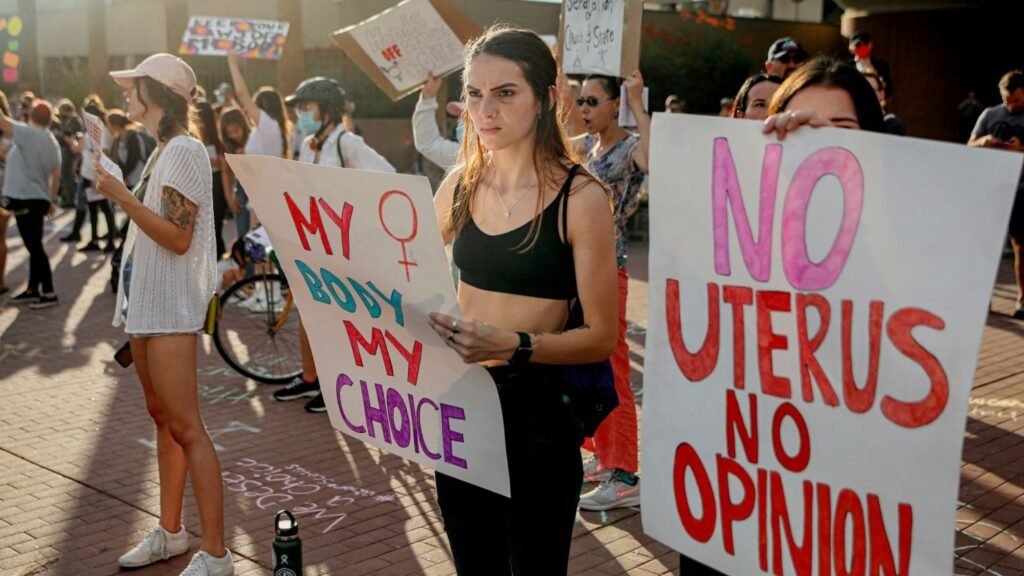American states show a clear divide in their abortion laws. Twelve states now enforce complete bans, and four others limit the procedure after six weeks of pregnancy. The reproductive healthcare scene has grown more complex after Roe v. Wade’s overturn in 2022. State laws now vary dramatically. Louisiana enforces prison sentences up to 15 years for healthcare providers. New York takes the opposite approach by protecting doctors who prescribe abortion medication to patients in other states.
These changing laws affect communities well beyond state lines. Telemedicine now accounts for one-fifth of all abortions in our country. Americans have found ways to access care despite tough restrictions. Recent developments in state abortion laws signal major changes that reshape the future of reproductive rights. Healthcare providers and patients face new challenges as these laws continue to evolve nationwide.
Supreme Court Reverses State Abortion Bans
The Supreme Court’s decision on June 24, 2022, changed American reproductive rights forever by overturning almost 50 years of constitutional protection for abortion. This ruling in Dobbs v. Jackson Women’s Health Organization altered the map of abortion access nationwide.
How Did We Get Here?
Mississippi started this chain of events by enacting a 15-week abortion ban that challenged what Roe v. Wade had established. The state went even further and asked the Supreme Court to completely overturn Roe. This was the first time since Roe that anyone asked the Court to look at whether a pre-viability abortion ban was constitutional.
Which States Face Immediate Impact?
The effects of this reversal hit hard and fast. Thirteen states put complete abortion bans into action right away. South Dakota, Kentucky, and Louisiana kicked in their “trigger laws” – rules they had ready just waiting for Roe to fall. Idaho, Tennessee, and Texas followed suit after waiting 30 days.
States fell into clear groups:
- States that banned abortion instantly through pre-Roe laws
- States that activated trigger bans
- States that kept abortion protections
Ten states protect abortion rights through their state courts, including Alaska, California, and Florida. Notwithstanding that, legal battles rage on in several states. To name just one example, North Dakota’s ban got temporarily overturned, but the state supreme court will end up deciding its fate. On top of that, some states still have their pre-Dobbs restrictions in place.
This ruling reaches way beyond just bans. Monthly abortion numbers in America have actually gone up, mainly because more people can access medication abortions and get help with travel. The post-Roe world keeps changing as states adjust their laws and courts tackle new challenges.
Healthcare Providers Resume Services Across America
American healthcare facilities have started offering abortion services again after recent court decisions. The phones at Women’s Med in Indianapolis began ringing right after the state lifted its abortion ban. The facility resumed services the very next day.
Clinics Reopen Their Doors
Whole Woman’s Health made plans to restart operations. The road to reopening comes with its share of hurdles. These clinics run on slim profit margins because health insurance doesn’t usually cover procedures and federal funding isn’t available. Many facilities turned to fundraising to keep running. One Florida clinic aims to raise $100,000 to keep its services going.
Telemedicine Expands Access
Telehealth services play a vital role and now make up nearly 10% of all U.S. abortions. A study looking at data from over 6,000 patients in 20 states and Washington D.C. showed telemedicine abortions worked 99.8% of the time. The results revealed 98% of patients needed no follow-up care.
New Safety Protocols Emerge
The World Health Organization released new guidelines for healthcare providers that focus on:
- Complete care including counseling and pain management
- Support for self-managed medical abortions
- Implementation of telemedicine protocols
Clinical practices underwent notable changes. Planned Parenthood’s Fairview Heights center extended its hours to 10 hours daily, six days a week. The facility added more medical staff to handle increased patient numbers as wait times jumped from 2-3 days to almost three weeks. The center’s records show 85% of their abortion patients travel from other states.
Federal Government Strengthens Abortion Protection
The Biden administration has rolled out detailed federal measures to protect abortion access nationwide. A new privacy rule now stops anyone from sharing protected health information about reproductive healthcare. This protection helps women who travel between states for abortion care. Data reveals 92,100 women crossed state borders for procedures in early 2023.

Biden Administration Issues New Guidelines
The Department of Health and Human Services has put several important provisions in place to support reproductive healthcare access:
- Better contraception coverage under the Affordable Care Act
- Stronger privacy protections for patients and providers
- More emergency medical care requirements
- Protection for healthcare providers who treat out-of-state patients
The Office of Personnel Management backs these changes with new guidance to improve contraception access for federal workers, retirees, and their families. The administration stands firm that required emergency care can include abortion services in certain cases.
Congress Debates National Legislation
The Women’s Health Protection Act of 2021 is the life-blood of federal legislative efforts. This bill would create a federal statutory right to abortion that could override state-level restrictions. State lawmakers responded by introducing 369 bills to protect abortion access. Of these bills, 77 passed in 18 states.
Republican lawmakers continue to push for more restrictive measures in this legislative landscape. The debate has changed since the Supreme Court’s decision. Congressional Republicans now pursue less aggressive anti-abortion legislation compared to previous sessions. The administration keeps asking Congress to bring back federal protections. They stress the need for national legislation to create consistent abortion rights in all states.
States Scramble to Adapt Their Legislation
Legal battles over abortion access have grown fiercer in state courts. Twenty-three states now try to enforce complete bans or restrictions before viability. Courts have blocked these bans in six states.
Republican States Face Legal Challenges
State abortion bans led by Republicans face three main legal arguments. Constitutional challenges in states like Ohio, Oklahoma, and Georgia claim their state constitutions cover abortion rights. Ten states with abortion bans have removed exceptions for pregnancies from sexual assault. Doctors in states with medical emergency exceptions won’t provide care unless a patient’s life faces immediate danger.
Democratic States Improve Protection Laws
Democratic states have created strong protective measures that include:
- Shield laws that protect providers and patients from legal action in other states
- More funding, with California setting aside $200 million for reproductive healthcare
- Rules that stop license plate readers from tracking abortion patients
Illinois saw the biggest jump in patients from other states. The state helped 18,870 people in early 2023 – three times more than in 2020.
Interstate Commerce Questions Arise
Questions about crossing state lines for abortion create complex legal issues. Idaho became the first state to limit interstate travel by making it illegal to help pregnant minors. States and counties that ban abortion now make it harder to travel out of state. Attorney General Merrick Garland says the Constitution limits states’ power to ban reproductive services outside their borders.

Conclusion
America’s reproductive rights battle continues to alter the healthcare landscape. The Supreme Court’s decision has led to a maze of different state laws. Healthcare providers have adapted well by using telemedicine to help patients across state lines with great success rates.
New federal guidelines and stronger privacy protections now provide a safety net for women who need care. The picture at state level shows a clear divide. Republican states push to tighten restrictions while Democratic states work to protect these rights. Recent numbers reveal thousands of women now travel between states to get care. Illinois has seen its out-of-state patient numbers triple since 2020.
Reproductive rights remain a heated issue in America. Courts block various state bans as new protective measures take shape. The healthcare system shows remarkable resilience as it adapts to serve patients. America’s reproductive healthcare evolution proves that access to vital care continues through groundbreaking solutions, unwavering commitment, and smart policy shifts.
FAQs
The reversal of state abortion bans has led to the reopening of clinics and the resumption of services across America. Healthcare providers are adapting to meet increased demand, with some clinics expanding operating hours and increasing staff. Telemedicine has also emerged as a crucial solution, now accounting for a significant portion of U.S. abortions.
The Biden administration has implemented new guidelines to strengthen abortion protection, including enhanced contraception coverage, strengthened privacy protections for patients and providers, and expanded emergency medical care requirements. The administration is also urging Congress to restore federal protections through national legislation.
Republican-led states are facing various legal challenges to their abortion bans. These challenges primarily focus on broad constitutional arguments claiming state constitutional protections encompass abortion rights. As a result, several states have had their bans blocked by courts.
Democratic-led states have enacted protective measures such as shield laws to protect providers and patients from out-of-state legal consequences, increased funding for reproductive healthcare, and laws prohibiting the use of license plate readers to track abortion patients. Some states have also seen a significant increase in out-of-state patients seeking care.
The overturning of Roe v. Wade has led to complex legal questions regarding interstate abortion access. Some states where abortion is banned have implemented measures complicating out-of-state travel for abortion care. However, the federal government maintains that states cannot ban reproductive services provided outside their borders. This has resulted in thousands of women crossing state lines to access abortion care.










Discussion about this post